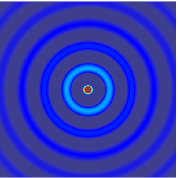
Photo from wikipedia
The mechanical properties of sandstones, including porosity, density and elastic moduli, can be estimated non‐destructively through elastic wave‐velocity measurements. Here, the variation of elastic wave velocity with porosity in sandstones… Click to show full abstract
The mechanical properties of sandstones, including porosity, density and elastic moduli, can be estimated non‐destructively through elastic wave‐velocity measurements. Here, the variation of elastic wave velocity with porosity in sandstones is modelled using Maxwell's effective field theory, extended to the elasticity of heterogeneous media by Sevostianov and coworkers. Comparing measured and predicted elastic wave velocities shows that on deposition, pores in sandstones are less stiff than spherical pores, but that their stiffness increases as porosity decreases. This suggests that concavity of pores in sandstone decreases with decreasing porosity. This interpretation is confirmed by the simple model of Sevostianov and Giraud in which concave pores are represented as superspherical pores, defined by a shape parameter that allows the effect of pore concavity on elastic wave velocities to be investigated. Inversion of measured velocities for this parameter indicates that pore concavity decreases with decreasing porosity. Moreover, values of the shape parameter obtained by inverting measured P‐velocities alone are found to give a good prediction of both P‐ and S‐wave velocities, confirming the applicability of the model.
Journal Title: Geophysical Prospecting
Year Published: 2021
Link to full text (if available)
Share on Social Media: Sign Up to like & get
recommendations!